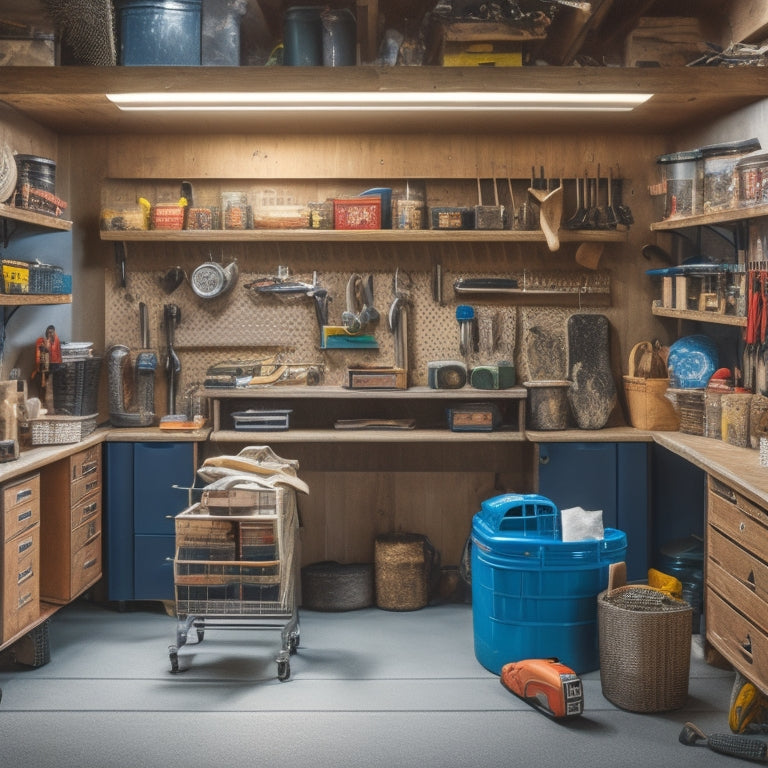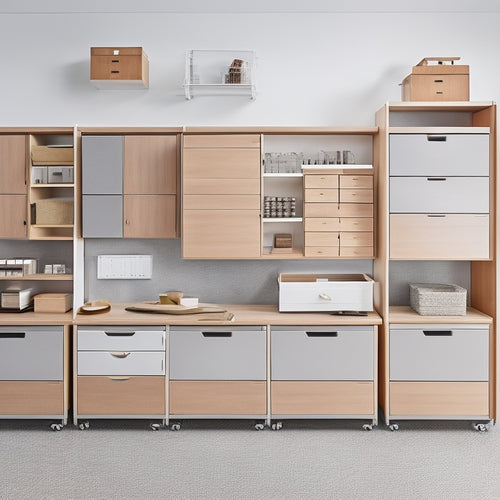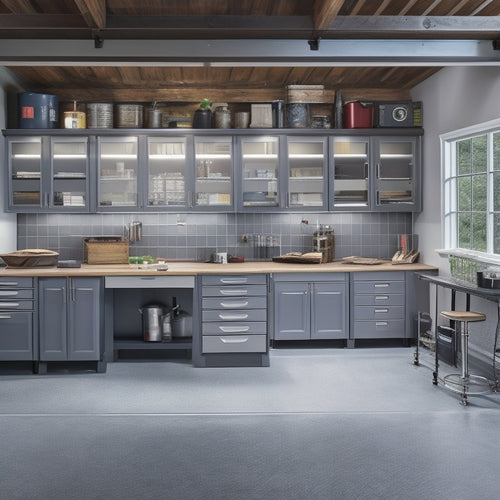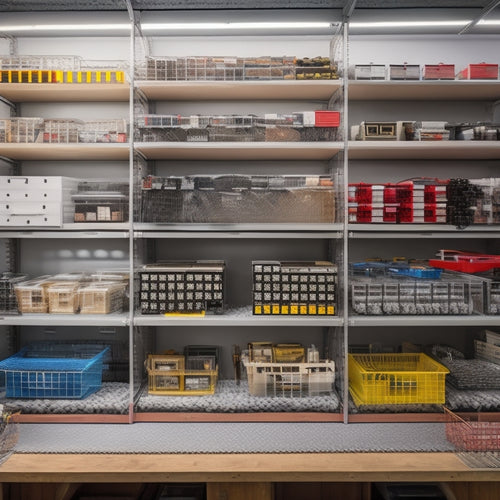
What's the Best Way to Declutter Your Garage?
Share
You're about to tackle the challenging task of decluttering your garage! Start by evaluating your space, considering your goals and taking stock of items. Be honest about what you use and what's just taking up space. Purge broken or unused items, then design a storage system that fits your needs. Categorize items into groups, assign a home for each, and utilize vertical storage space. Build shelving and cabinets that maximize space, and label everything for easy identification. As you get organized, you'll realize it's not just about getting rid of stuff, but about creating a system that works for you - and there's more to explore to make that happen.
Key Takeaways
• Assess your garage space by considering goals, conducting a space inventory, and taking stock of items to decide what to keep, donate, or discard.
• Purge unwanted items by starting with broken or beyond repair items and being honest about usage and emotional attachment.
• Design a storage system by categorizing items, assigning a home for each group, and using modular storage units with labels for easy identification.
• Utilize vertical storage space by maximizing wall space with shelving, hooks, and bins, and thinking vertically for efficient storage.
• Set regular check-ins to revisit and refine your storage system, find an accountability partner, and identify areas needing improvement.
Assessing Your Garage Space
Take a step back and examine your garage space objectively, considering how you currently use it and what you want to achieve from the decluttering process. Think about your garage goals - do you want a tidy space for parking your car, a workshop for projects, or a storage area for seasonal items? Establishing clear goals will help guide your decluttering process.
Next, conduct a space inventory to identify the areas that need the most attention. Walk through your garage and make note of the layout, including the location of windows, doors, and any built-in storage.
Take stock of the items you have, including tools, sports equipment, and seasonal decorations. Consider the frequency of use and the condition of each item. This inventory will help you decide what to keep, what to donate or sell, and what to discard.
Purging Unwanted Items First
With your garage space inventory in hand, start purging unwanted items by tackling the easiest decisions first, such as broken or damaged items that are beyond repair. This will give you a sense of accomplishment and momentum to tackle the tougher decisions ahead. Next, sort items into three categories: keep, donate/sell, and discard.
| Category | Reason | Action |
|---|---|---|
| Keep | Still useful or sentimental value | Store in designated area |
| Donate/Sell | Still in good condition, no longer needed | Research donation strategies or sell through online marketplaces |
| Discard | Broken, damaged, or useless | Dispose of responsibly |
Be honest with yourself about each item. If you haven't used it in the past year, it's likely you won't miss it. Let go of emotional attachment to items that no longer serve a purpose. Remember, the goal is to create a functional and organized garage space that sparks joy, not stress. By purging unwanted items, you're one step closer to achieving that goal.
Designing a Storage System
Now that you've purged your garage of unwanted items, it's time to create a storage system that maximizes your available space and keeps your remaining possessions organized and easily accessible. To do this, you'll need to design a system that's tailored to your specific needs.
Start by categorizing your items into groups, such as tools, sporting equipment, and seasonal decorations. Next, assign a home for each group, considering the frequency of use and the items' size and shape.
A flexible layout is key to a successful storage system. Consider using modular storage units that can be easily rearranged as your needs change. Use custom labels to identify what's stored in each unit, making it easy to find what you need in a snap.
You can also use bins and baskets to store smaller items, keeping them out of sight but still accessible. By designing a storage system that's tailored to your needs, you'll be able to find what you need quickly and easily, and keep your garage organized and clutter-free.
Building Shelving and Cabinets
You'll need to build shelving and cabinets that provide ample storage and are tailored to the specific items you've categorized and assigned a home for in your storage system. This is where you get to create a space that's truly customized to your needs. Think about the types of items you'll be storing and how you can design your shelving and cabinets to accommodate them.
Here are a few things to take into account:
-
Corner solutions: Don't waste the often-wasted space in corners! Install shelves or carousels that maximize this area.
-
Custom installations: Take into consideration investing in custom-built cabinets or shelving that fit your specific needs. This might be more expensive upfront, but it'll pay off in the long run with increased storage and a more streamlined look.
-
Adjustable shelves: Choose shelving units with adjustable shelves to make sure you can accommodate items of varying sizes.
Utilizing Vertical Storage Space
Now that you've built shelving and cabinets, it's time to think up - not out. You'll be amazed at how much more storage you can squeeze out of your garage by utilizing vertical space.
Maximize Wall Space
Install shelving, hooks, and bins on your garage walls to create a functional and organized space that takes advantage of often-wasted vertical storage capacity. By doing so, you'll free up floor space and keep your garage clutter-free.
When it comes to maximizing wall space, the key is to think vertically.
Here are some ideas to get you started:
-
Bike Hooks: Hang your bikes from the ceiling or install hooks on the wall to keep them organized and out of the way.
-
Decorative Shelves: Add some style to your garage with decorative shelves that can hold bins, baskets, or other storage containers.
-
Adjustable Shelving: Invest in adjustable shelving that can be customized to fit your specific storage needs.
Use Ceiling Storage
Take advantage of your garage's often-overlooked ceiling storage by utilizing overhead space to stash items that are less frequently used, freeing up valuable floor and wall space for more essential items. This vertical storage space is perfect for storing seasonal decorations, out-of-season clothing, or even luggage.
You can install overhead bins or shelves to store these items, making it easy to access them when needed. Consider incorporating hidden compartments or secret storage areas to keep valuable or sensitive items out of sight.
Here are some popular ceiling storage options worth exploring:
| Storage Option | Description | Benefits |
|---|---|---|
| Overhead bins | Sturdy, waterproof bins for storing bulky items | Easy to install, keeps items dry |
| Ceiling-mounted shelves | Adjustable shelves for storing boxes or bins | Customizable, maximizes space |
| Hidden compartments | Secret storage areas behind ceiling panels | Secure, discreet storage |
| Pulley systems | Ropes and pulleys for lifting heavy items | Easy to access, reduces strain |
Maintaining Organization Long-Term
Maintaining your decluttered and organized garage is crucial to sustaining this new state of order.
To do so, you'll need to establish habits and routines that will help you keep your garage organized over time.
Set Up a System
You'll need to establish habits and routines to guarantee your newly organized garage stays clutter-free in the long run. This is where setting up a system becomes essential in maintaining your hard-won organization.
To create an effective system, consider the following:
-
Label categories: Clearly label each category or zone in your garage, such as 'Tools' or 'Seasonal Decorations'. This will help you and others quickly identify where items belong.
-
Zone workflow: Designate specific areas for specific tasks, like a workstation for DIY projects or a zone for bike maintenance. This will streamline your workflow and prevent clutter from building up in the future.
-
Regular maintenance: Schedule regular tidying sessions to maintain your garage's organization. This can be as simple as dedicating 15 minutes a week to putting away tools or tidying up your workspace.
Assign a Home
Assigning a designated spot for each item in your garage guarantees that everything has a place to return to, making it easier to maintain your newly organized space over time. This means you'll no longer have to search for misplaced items or deal with clutter buildup. To achieve this, label zones and designate stations for specific categories of items. For instance, you can have a zone for gardening tools and a station for sports equipment.
| Zone/Station | Description |
| Gardening Zone | Rakes, shovels, seeds, and other gardening essentials |
| Sports Station | Bikes, balls, gloves, and other sports-related items |
| Tool Zone | Hammers, drills, screwdrivers, and other tools |
| Seasonal Station | Decorations, lights, and other seasonal items |
| Storage Zone | Infrequently used items, such as luggage and camping gear |
Schedule Regular Check-Ins
To guarantee your garage remains organized and clutter-free, set a recurring schedule to revisit and refine your storage system, tackling any disorganization that may have crept in since your initial decluttering effort. This regular check-in will help you maintain your hard-won organization and prevent clutter from building up again.
Here are some tips to make the most of your regular check-ins:
-
Find an Accountability Partner to join you in your decluttering journey and provide motivation when you need it.
-
Schedule a Seasonal Refresh every 3-4 months to tackle any seasonal items that may have accumulated, such as winter gear or summer toys.
-
Take photos of your organized garage and compare them to your 'before' photos to see how far you've come and identify areas that need improvement.
Frequently Asked Questions
Can I Sell or Donate Items That Are Still in Good Condition?
"You can definitely sell or donate items still in good condition! Consider listing them on online marketplaces like eBay or Craigslist, or reach out to local charities that accept gently-used items, like Goodwill or Habitat for Humanity ReStores."
How Do I Handle Hazardous Waste Disposal in My Garage?
You'll want to separate hazardous items like batteries, paint, and chemicals, then research local eco-friendly disposal options, like designated drop-off centers or special collection events, to guarantee you're handling them in a responsible, environmentally conscious way.
What's the Best Way to Organize Seasonal Decorations and Items?
Imagine your seasonal decorations as a treasure chest, overflowing with hidden gems. You're the curator, tasked with categorizing and storing them. Create Label Categories, like "Winter Wonderland" or "Summer Soiree," and assign Zone Storage areas, ensuring each item has a designated home, making it easy to find and display.
Can I Use Garage Space for a Home Office or Gym?
You're considering repurposing your garage as a home office or gym? First, plan a functional workspace layout, then explore soundproofing options to minimize distractions and create an ideal environment that suits your needs.
How Do I Keep Pests and Rodents Out of My Garage Storage?
"Your garage storage is like a treasure chest, but pests and rodents can turn it into a nightmare! You'll want to seal any entry points, like cracks and crevices, and screen vents to keep unwanted critters out."
Related Posts
-

Modular Tool Storage Systems for Small Spaces
You can optimize your small workspace by leveraging modular tool storage systems that intelligently employ vertical s...
-

Best Tool Chests for Home Garage Options
When selecting the best tool chest for your home garage, you'll want to evaluate top brands like DeWalt, Milwaukee, a...
-

10 Essential Steps for Small Parts Bin Storage
To optimize your small parts bin storage, start by defining your storage needs and goals, considering factors like av...


